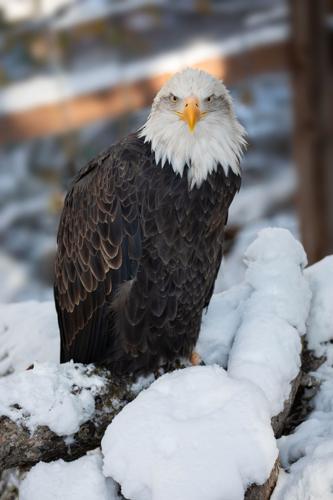National bird: Best spots to view bald eagles around Colorado Springs
North America’s great white-capped bird of prey is finally official.
On Christmas Eve, President Joe Biden signed a law making the bald eagle the national bird of the U.S. It’s been a long time coming, especially since many Americans already thought the bird was our national bird.
“I get why it’s the eagle. They represent power, majesty and grace,” said Fountain Creek Nature Center Supervisor Jessica Miller. “I learned recently they were not officially our national bird. It’s overdue.”
And we don’t have to go far to find them in the Pikes Peak region.
“Bald eagles are found near water,” said Fountain Creek Nature Center Supervisor Jessica Miller. “They like to eat fish but people don’t realize how much they like to eat waterfowl, like ducks. Anywhere you can find waterfowl, that’s a good place to look for them. In the Pikes Peak Region we do have a lot of sources of water.”
Bald eagles, which can only be found in North America, have long been a symbol of the nation. Their image has appeared on the Great Seal of the U.S., used in government documents, since 1782. They adorn money and are used as the insignia for the country’s military branches, departments and agencies. The bird also is an integral part of the spiritual lives and sacred belief systems of most Indigenous peoples and Tribal communities, the newly signed bill states.
The Front Range is home to a large population of the regal birds, according to Kara Van Hoose with Colorado Parks and Wildlife, and often the best times to spot one is around February, March and April, when they nest.
This past year was a great one for the species in Colorado, with an estimated 480 occupied nests, Van Hoose said.
And while bald eagle populations have grown significantly, that hasn’t always been the case. The U.S. Fish and Wildlife Service calls them an “Endangered Species Act success story.”
In the mid-1900s, the birds were in danger of extinction due to habitat destruction, illegal shooting and pesticide use, especially that of DDT, which was banned in 1972. In 1940, Congress passed the Bald Eagle Protection Act, which prohibited killing, selling or possessing the species.
By 1963, there were only 417 nesting bald eagle pairs known to exist. The species was listed as endangered in 1978 following the enactment of the Endangered Species Act, which allowed for recovery efforts like captive breeding and nest site protection during breeding season.
In 2007 they were taken off the endangered species list, when the FWS estimated more than 9,500 nesting pairs in the U.S., but they remain protected under the Migratory Bird Treaty Act and the Bald and Golden Eagle Protection Act.
“You feel a sense of connection with nature when you see them,” Van Hoose said. “It’s a really special thing to see.”
Tips for spotting bald eagles in the Front Range
Look high: Bald eagles tend to nest in tall trees, particularly Cottonwood trees, high above the ground, Van Hoose said. Check for dead tree limbs, or those scarce of foliage, since eagles will often choose those areas for nests to have better visibility of the hunting land below.
Go where there’s water.
Look for white heads: Bald eagles are most easily spotted by their unique white heads, which inspired their name.
Bring binoculars: Because they’re usually high up in trees or soaring through the sky, they’re best spotted with binoculars or spotting scopes.
Respect eagles and all wildlife: Keep your distance from the birds and other wildlife. Pick up trash to keep birds from eating or getting caught in it. Leave bald eagle feathers and other remnants alone. It is illegal to collect bald eagle parts, including feathers, nests and eggs.
Where to spot bald eagles around the Pikes Peak region
• Fountain Creek, Monument Creek and the ponds at Fountain Creek Nature Center: “We have a winter bird count the second Saturday of January,” Miller said. “After every count, when groups get back to tally the species we saw, we all end up seeing bald eagles.”
• Big Johnson Reservoir in Bluestem Prairie Open Space: South of the old Colorado Springs Airport in Security-Widefield. There’s a tremendous amount of water year-round, Miller said, and lots of ducks in the winter.
• Prospect Lake in Memorial Park, 1605 E. Pikes Peak Ave.
• Quail Lake: Southwest side of Colorado Springs, off Cheyenne Mountain Boulevard
• Sinton Pond Open Space: North of Fillmore and running alongside Sinton Road
• DoubleTree by Hilton Hotel pond, 1775 E. Cheyenne Mountain Blvd.
• Clear Spring Ranch: South of Fountain
• Mallard Pond: In Falcon near U.S. 24 and East Woodmen Road
• Hale Reservoir in Cross Creek Regional Park: A little body of water in Fountain.





